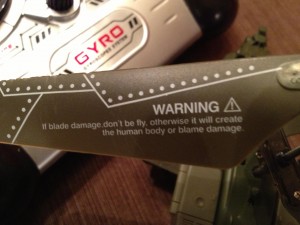A few months ago, just back from maternity leave, I blogged about how I was feeling so inundated with warning labels. We had just finished a house renovation, and I’d just had my second child, so the number of warning labels on everything from the new tub to the baby’s carseat were starting to drive me a little batty. Okay, it could have been the sleep deprivation too, but I did wax poetic on the warning labels issue in that post.
Case in point. Recently, I received a notice by email and in the mail that there has been a recall on Bumbo Baby Seats. If you have no idea what I’m talking about, here’s a picture of one of these contraptions before the recall:
 Now, I know it looks like a medieval torture device. It’s not. It’s one of the best baby products ever invented. You put your not-quite-sitting-up-infant in the seat and WHAMO! He can sit up! The seat is light, and babies love it. One important thing about this seat, or at least I thought, is that the baby is so wedged into the chair that he can’t tip it over, or tip himself out of it. Both my sons have used the Bumbo, and neither one has ever tipped out of it.
Now, I know it looks like a medieval torture device. It’s not. It’s one of the best baby products ever invented. You put your not-quite-sitting-up-infant in the seat and WHAMO! He can sit up! The seat is light, and babies love it. One important thing about this seat, or at least I thought, is that the baby is so wedged into the chair that he can’t tip it over, or tip himself out of it. Both my sons have used the Bumbo, and neither one has ever tipped out of it.
Even before the recall, there were warnings. Users are told not to use it in the bathtub or on raised surfaces, and there is also a warning to always watch your baby when he’s in it. Well, it appears that wasn’t enough. Apparently, some babies more determined than mine did, in fact, succeed in tipping themselves out of the Bumbo. So, the company has issued a recall, and this is what the seat looks like since the company added a seatbelt:

And, of course, there is a new warning label to be affixed over the old one, something called “repair kit instructions,” and a video about how to properly use the Bumbo.
I know I’m being flippant. Many infants and children are injured every year when products made for them are misused, or even when they are used properly (thus the recalls). I’m not trying to trivialize those cases. I do, however, see this as an example of the common sense filter I talked about in that prior post.
A quick comparison of the warnings included with the Bumbo prove my point. The warning not to use the Bumbo in the bathtub is quite helpful–the seat resembles another product that is used to help a child sit up in the bathtub, and I can see how someone might confuse the two. But an instruction not to leave the child unattended? And a warning not to put a baby in the seat on a raised surface? Come on folks. That’s parenting/child care 101. Those types of warnings are the worst, because they give us an excuse not to think for ourselves. We get lazy, and believe that we need to be spoon-fed our own common sense. We should expect–and want–better for ourselves.



















